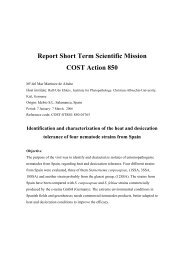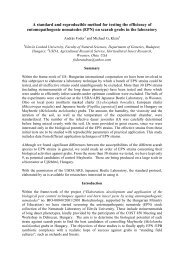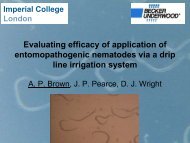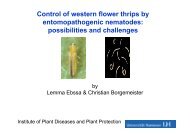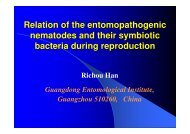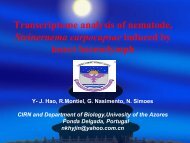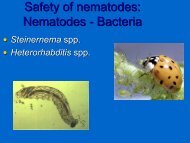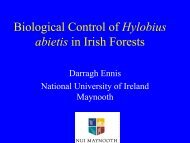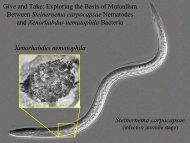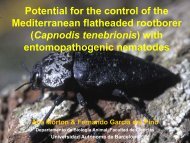Download PDF, 569 KB - COST Action 850
Download PDF, 569 KB - COST Action 850
Download PDF, 569 KB - COST Action 850
- No tags were found...
You also want an ePaper? Increase the reach of your titles
YUMPU automatically turns print PDFs into web optimized ePapers that Google loves.
Control of the hazelnut weevilCurculio nucum withentomopathogenic nematodesArne Peters 1 , Jean-PaulSarraquigne 2 , Bernard Blum 3 ,Stefan Kuske 4-nema GmbH, a.peters@e-nema.dessociation Nationale des Producteurs de Noisette (ANPN), France, jps.anpn@unicoqgrometrix, Switzerland, agrometrix.blum@balcab.chgroscope, Switzerland, stefan.kuske@faw.admin.ch
The problem• Losses in hazelnut plantations• Common treatment: insecticide againstadults (endosulfan and/or carbaryl toadults)• Alternative: Soil treatment to reduce weevilpopulation
Life cycle• Overwintering adults lay eggs in springaround 10th of June• Infested nuts fall from end of July to midAugust, larvae leave nuts• 2 weeks ahead in 2003• Larvae spend winter in soil and pupatenext spring and emerge in summer• Many larvae pupate only after 4-5 years
Percent infected / dead100%90%80%70%60%50%40%30%20%10%0%Laboratory assessmentsandy-loaminfecteddead100 n/larvaN=248 days22°CSandS. feltiaeH. bacteriophoraS. feltiae 2. trialControl50 n/larvaS. carpocapsae
Lab-results with H. indica1210±1.96*Std. Err.±1.00*Std. Err.MeanDEAD larvae (10 treated)86420Soil from orchard-20 0.5 1 5nematode dose (Mill IJs/m²)
Field trials• LOCALISATION OF THE TRIAL :EARL DE PEYRAL (M. Patrick CHASSAC) 47290 BEAUGAS• ORCHARD CARACTERISTICS :- CORABEL variety, (12 years old)- 6 by 3 meters spacing ;- Clay soil, calcareous ;- Micro sprinkler system (water flow is 20 litres per hour)
Trial design• 3 nematodes strains, plus an untreated control• Evaluation over 4 years (1/4 of plots each year, until 2007)• 5 replications per modality (= strain x investigation year)• All together 80 containers38 cm in diameter,50 cm depth,46 litres in capacity• Completely randomised block design
First evaluation in 2003Number of living larvae18.0016.0014.0012.0010.008.006.004.002.000.00HIN PLUS CON TOPNematode strainErroneously treated with 2.2 million / m² !
Treated with 0.5 million / m² !Second treatment andevaluation in 200435.0030.00Living larvae25.0020.0015.0010.005.000.00HIN PLUS CON TOPTraitement
Vertical distribution of larvae (2003)2945402735±1.96*Std. Err.Min-Max±1.00*Std. Err.25%-75%MeanMedian valueDepth weighted by larvae found30252520231510215190S. feltiae H. bacteriophora H. indica ControlS. feltiae H. bacteriophora H. indica ComtrolTREATMENT
DepthVertical distribution of larvae 200356Histogram (PROF_03.STA 4v*231c)TIEFE y = 232 * 5 * normal (x, 23.86206, 8.83215)5248444036No of larvae322824201612840 45
Vertical distribution 200421.645±1.96*Std. Err.±1.00*Std. Err.Mean213520.4 2519.8 15Depth by larvaeMin-Max25%-75%Median value19.2518.6-5Control tem H. bacteriophora top S. feltiae plus H. hin indicaTREATMENT
Vertical distribution 2004Histogram (PROF_04.STA 7v*295c)y = 295 * 5 * normal (x, 20.01016, 8.168915)7570656055Number of larvae50454035302520151050 40depth
Conclusions• Best results with H. indica and H.bacteriophora• Larvae in soil deep and scattered• Solutions:– Application timing ?– Lure larvae with soil moisture ?– Apply nematodes via sprinkler or dripirrigation• Emergence significantly reduced• Long term control strategy
Beetle emergence in 2005total number of beetlesfound98765432100.0H. bacteriophora(n=15)beetles/plots expected mean beetles/plot0.10.5S. feltiae (n=15) H. indica (2004;n=6)Treatment0.7control (n=12)0.70.60.50.40.30.20.10.0Plots infested 2003treated 2003H. indica treated 2004Few beetles found:- heavy rain- emergence in 2006/2007



